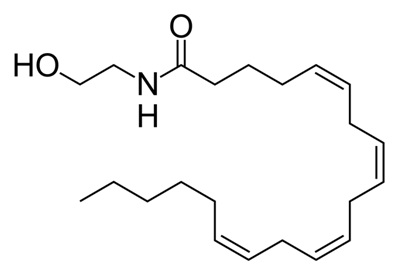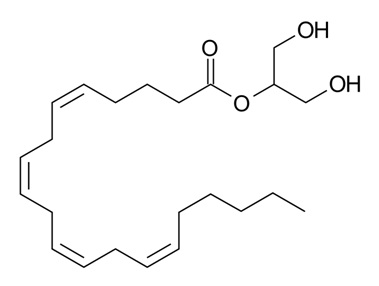Endocannabinoid system (ECS)
The discovery of the endogenous cannabinoid signaling system, i.e.
endocannabinoid system (ECS) opened a whole new field of research. Just like other physiological systems, such as the opioid system and the serotonergic system, the ECS is comprised of receptors {call-out, text:Binding places in the body where molecules can induce actions}, their endogenous {call-out, text:Originating from the body} ligands {call-out, text:Molecules that bind to the receptors and that can induce or block actions}, and proteins responsible for the production, transport, and degradation of those ligands.
The ECS was discovered in the early 1990s with the discovery of the endogenous cannabinoid anandamide, or AEA, (see Figures 1 and 2; see section
Endocannabinoids) and the subsequent cloning of the cannabinoid receptor type 1 in 1990 and type 2 in 1993.
1, 2 The regulation of feeding was believed to be the initial function of the ECS in primitive organisms. For example, De Petrocellis showed that in the Hydra (
Cnidaria Hydrozoa), the endogenous cannabinoid receptor ligand anandamide, when bound to the cannabinoid binding site, inhibited the feeding response by accelerating mouth closure.
3 The rudimentary nervous system of the Hydra was described in 1919 by Dr. Parker and has been found in fossils dated more than 500 million years old – that means that the ECS must be very old as well, with its basic function being deeply embedded in our signaling system.
3, 4 In more complex organisms, like humans, it is thought that the ECS’s main function evolved into controlling
homeostasis, or a balance of the systems in the body. This means that during a state of illness, the ECS changes activity in order to compensate for the illness and to keep the balance.
5
 Figure 1: Anandamide (AEA) – an arachidonic acid-containing lipid molecule generated from membrane glycerophospholipids (image taken from Wikimedia.).
Figure 1: Anandamide (AEA) – an arachidonic acid-containing lipid molecule generated from membrane glycerophospholipids (image taken from Wikimedia.).
 Figure 2: 2-Arachidonoylglycerol (2-AG) – a monoacylglycerol (MAG) molecule containing an esterified arachidonic acid chain at sn-2 position of the glycerol backbone 6 (image taken from Wikimedia).
Figure 2: 2-Arachidonoylglycerol (2-AG) – a monoacylglycerol (MAG) molecule containing an esterified arachidonic acid chain at sn-2 position of the glycerol backbone 6 (image taken from Wikimedia).
- Devane, W. A.; Hanus, L.; Breuer, A.; Pertwee, R. G.; Stevenson, L. A.; Griffin, G.; Gibson, D.; Mandelbaum, A.; Etinger, A.; Mechoulam, R. (1992). Isolation and structure of a brain constituent that binds to the cannabinoid receptor. Science (New York, N.Y.), 258(5090), 1946--1949.
- Munro, Sean; Thomas, Kerrie L.; Abu-Shaar, Muna (1993). Molecular characterization of a peripheral receptor for cannabinoids. Nature, 365(6441), 61--65.
- De Petrocellis, L.; Melck, D.; Bisogno, T.; Milone, A.; Di Marzo, V. (1999). Finding of the endocannabinoid signalling system in Hydra, a very primitive organism: possible role in the feeding response. Neuroscience, 92(1), 377--87.
- Parker, George Howard (1919). The elementary nervous system,. J.B. Lippincott Company.
- Ligresti, Alessia; De Petrocellis, Luciano; Di Marzo, Vincenzo (2016). From Phytocannabinoids to Cannabinoid Receptors and Endocannabinoids: Pleiotropic Physiological and Pathological Roles Through Complex Pharmacology. Physiological reviews, 96(4), 1593--1659.
- Ueda, Natsuo; Tsuboi, Kazuhito; Uyama, Toru; Ohnishi, Taira (2010). Biosynthesis and degradation of the endocannabinoid 2-arachidonoylglycerol. BioFactors, 37(1), 1--7.
 Figure 1: Anandamide (AEA) – an arachidonic acid-containing lipid molecule generated from membrane glycerophospholipids (image taken from Wikimedia.).
Figure 1: Anandamide (AEA) – an arachidonic acid-containing lipid molecule generated from membrane glycerophospholipids (image taken from Wikimedia.).
 Figure 2: 2-Arachidonoylglycerol (2-AG) – a monoacylglycerol (MAG) molecule containing an esterified arachidonic acid chain at sn-2 position of the glycerol backbone 6 (image taken from Wikimedia).
References:
Figure 2: 2-Arachidonoylglycerol (2-AG) – a monoacylglycerol (MAG) molecule containing an esterified arachidonic acid chain at sn-2 position of the glycerol backbone 6 (image taken from Wikimedia).
References:_logo.svg)